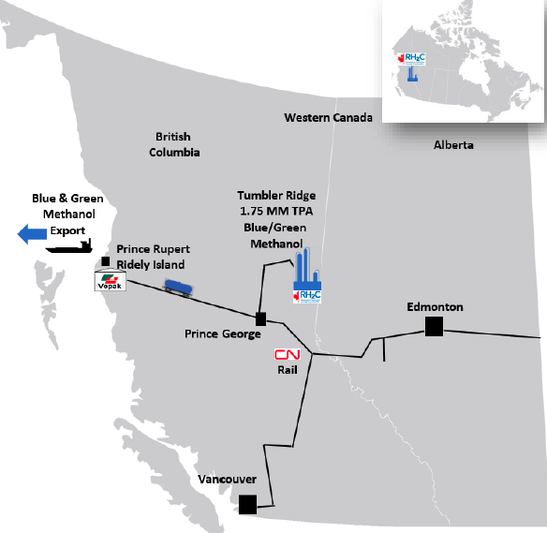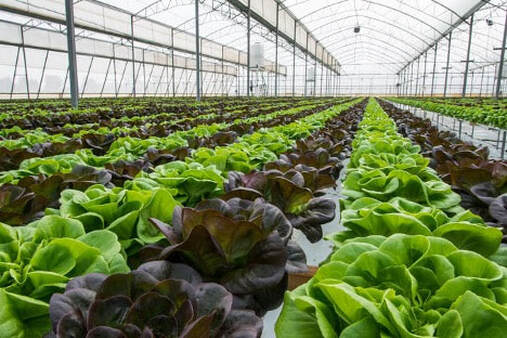
Tumbler Ridge methanol project
Renewable Hydrogen Canada Corporation (RH2C), through its subsidiary Canadian Methanol Corporation (CMC), is planning to produce green methanol (e-methanol) and low-carbon blue methanol at a world-scale plant near the town of Tumbler Ridge in northeastern British Columbia (BC). Both products will be transported by rail to a new bulk liquids storage facility on the coast near Prince Rupert in northwestern BC, the closest port in North America to Asia.
Demand for green and blue methanol as a marine fuel is on the rise and is thus a key driver of the project. Much groundbreaking engineering work has been completed. This is to be followed by a pre-feed study by Stantec Inc., an international professional services company in the design and services industry.
On March 14, 2023, the Government of British Columbia released its new energy action framework to cap emissions and electrify the clean economy of BC, promising to "establish a clean-energy and major projects office to fast track investment in clean energy and technology and create good, sustainable jobs in the transition to a cleaner economy." This initiative will help expedite Canadian Methanol's Tumbler Ridge project.

Feedstocks
• Renewable electricity
BC Hydro: Approx. 140 MW of firm power
Biomass plant self-generation: 20+ MW
Aeolis Wind Power: 400 MW initially
• Abundant supply of fresh water
• Natural gas
>50 TCF of low-CI recoverable from the massive Montney Formation
• Biogenic CO2 captured from wood waste from the province's forestry industry
Captured from combustion of wood pellets made with abundant waste biomass
Feedstocks
• Renewable electricity
BC Hydro: Approx. 140 MW of firm power
Biomass plant self-generation: 20+ MW
Aeolis Wind Power: 400 MW initially
• Abundant supply of fresh water
• Natural gas
>50 TCF of low-CI recoverable from the massive Montney Formation
• Biogenic CO2 captured from wood waste from the province's forestry industry
Captured from combustion of wood pellets made with abundant waste biomass
|
Production Total output: 1.75 million tons per annum (TPA) Green: 0.17 milion tons TPA, Carbon intensity (CI) of less than 10g/MJ (less than 300kg/tonne) Blue: 1.58 million TPA, CI of approx. 72 kg/GJ, well below the value for either conventional marine fuels (90-95 kg/GJ) or conventional methanol (90-95 kg/GJ). Over time, as world-scale wind projects in the region by wind developers such as Aeolis Wind, Evolugen and Boralex are completed, the output of blue methanol will decline and that of green methanol will rise. The ultimate goal is for all output to be green methanol. The enviable combination of wind, hydro power and biomass in the region makes this goal realistic. Plant site The CMC plant will be located at a secured, 30-hectare site near Tumbler Ridge. The site features a convergence of critical resources and infrastructure and by gaining control of it, RH2C has taken a huge step forward with its project to produce renewable and low-carbon methanol in northeastern BC. Rail logistics • Existing track with ample capacity that runs from the plant site directly to the port • Plant output to be transported by 110-car unit train every 48 hours Port terminal Port of Prince Rupert Time frame Much ground-breaking engineering work has been completed and a pre-feed study by Stantec is the next step. The facility is expected to start operations in early 2028. |

First Nations
CMC and West Moberly First Nations (WMFN) have an existing MOU whereby CMC will supply waste heat from the operation to a large-scale First Nations-owned and operated greenhouse complex that will be located adjacent to the methanol plant. Called Sundance Produce, this facility will grow organic produce for distribution throughout western Canada, including the north. It represents a tremendous entrepreneurial and employment opportunity for First Nations.
CMC and West Moberly First Nations (WMFN) have an existing MOU whereby CMC will supply waste heat from the operation to a large-scale First Nations-owned and operated greenhouse complex that will be located adjacent to the methanol plant. Called Sundance Produce, this facility will grow organic produce for distribution throughout western Canada, including the north. It represents a tremendous entrepreneurial and employment opportunity for First Nations.





